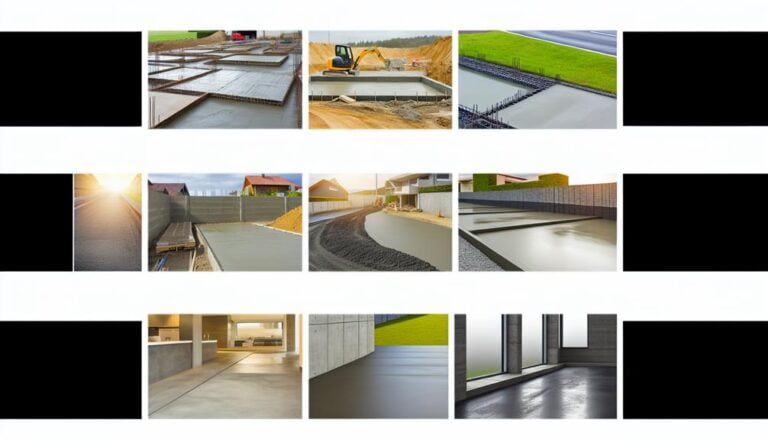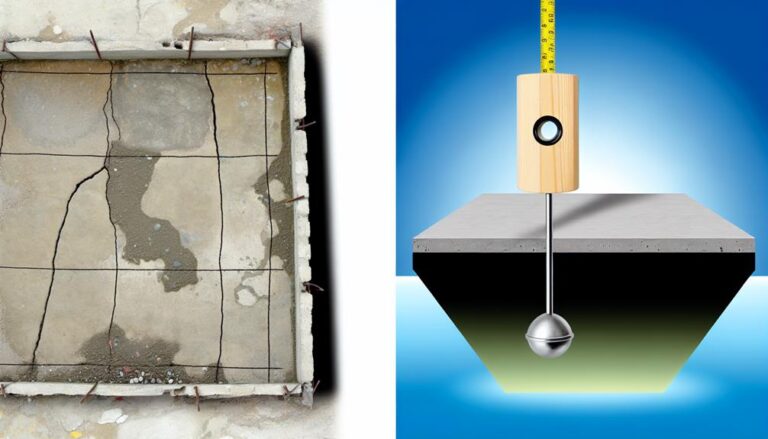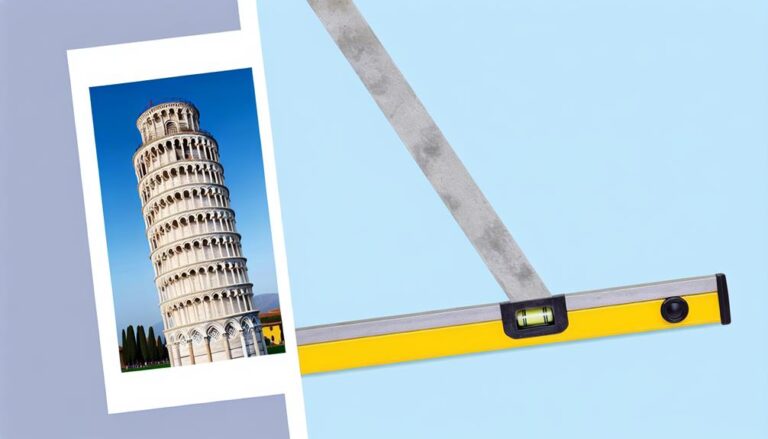Unlocking the Hidden Advantages of Concrete Leveling
Concrete leveling can unlock several hidden benefits for your construction project. This technique breathes new life into worn out surfaces, reducing costs by requiring fewer materials and less labor. It also boosts durability, extending the lifespan of your concrete and reducing repair needs. Your project becomes environmentally friendly as concrete leveling reuses materials, minimizing waste. The result? Safer surfaces and an upgraded aesthetic appeal! Finding out more could save you time and make your construction more efficient.
Understanding Concrete Leveling
Let's dive into the process of concrete leveling, a cost-effective and efficient method to fix uneven concrete surfaces. You might be wondering what it involves. Well, concrete leveling, also known as slabjacking or mudjacking, is a process that requires injecting a mixture, typically made up of cement and soil, beneath the concrete slab. This is done through strategically drilled holes. As the mixture is pumped, it fills the voids and lifts the slab, achieving a level surface.
Now, you're not just dealing with an aesthetic issue when you've got uneven concrete. This condition can pose a tripping hazard and cause water to pool and seep into your basement or foundation, causing further damage. That's where concrete leveling comes in. It's not just about making things look pretty – it's about safety and preventing further damage.
Cost-Effectiveness of Concrete Leveling
Unraveling the cost-effectiveness of concrete leveling, you'll find it's more affordable and efficient than completely replacing your concrete surfaces. This technique breathes new life into your worn-out concrete, saving you from the hefty price tag of total replacement.
- Less Labor Intensive: Concrete leveling requires less manual labor compared to a complete overhaul. You won't need to break and remove the existing concrete, which can be a time-consuming and costly process.
- Quick Turnaround: Time is money, and concrete leveling takes less time. Typically, the process can be completed in a day, allowing you to use your space sooner.
- Minimal Disruption: With concrete leveling, there's minimal disruption to your landscape or surroundings. You won't have to worry about extensive cleanup or damage to your property.
- Material Cost: Concrete leveling uses fewer materials than a full replacement. You'll save on the cost of new concrete and the disposal of old materials.
Durability and Longevity Benefits
You'll also reap the benefits of enhanced durability and longevity when you opt for concrete leveling. This method fortifies your concrete structures, making them withstand harsh conditions and resist wear and tear. They're built to last, ensuring that you won't need to worry about frequent replacements or costly repairs.
To put it in perspective, let's look at a table showcasing the difference in durability and longevity between leveled and unleveled concrete:
| Leveled Concrete | Unleveled Concrete | |
|---|---|---|
| Lifespan | Extends lifespan | Shorter lifespan |
| Wear and Tear | More resistant | Less resistant |
| Maintenance | Lower frequency | Higher frequency |
| Repair Costs | Reduced | Increased |
| Replacement Frequency | Less often | More often |
In a nutshell, concrete leveling gives you a sturdier, more resilient surface that will serve you well for years to come. This means less stress, less expense, and more peace of mind for you. It's a smart investment that will pay off in the long run, proving that there's more to concrete leveling than meets the eye.
Concrete Leveling and Environmental Sustainability
Digging deeper into the benefits of concrete leveling, it's also a champion for environmental sustainability. You may wonder how this is possible. Well, let's break it down.
- Reduced Waste: Concrete leveling typically utilizes the existing concrete slab. That means there's less need to produce new concrete, saving resources and reducing waste.
- Less Energy Consumption: By reusing the existing slab and minimizing the need for new concrete, energy that would otherwise be consumed in the production and transportation of new materials is conserved.
- Low Maintenance: Once your concrete is leveled, you won't need to worry about frequent repairs. Less maintenance means fewer resources spent, which is a win for the environment.
- Longevity: Concrete leveling enhances the durability of your concrete surfaces, meaning they last longer. Longer-lasting concrete means less frequent replacements, further reducing material usage and energy consumption.
Safety Advantages of Level Concrete
Now, let's delve into the safety benefits that level concrete provides. As you might already know, uneven surfaces aren't just unsightly, they're a tripping hazard. If you're responsible for a public space, you're also legally responsible for any injuries that result from uneven flooring. By leveling your concrete, you're reducing the risk of trips and falls, making your spaces safer for everyone.
But there's more to it than just reducing tripping hazards. Level concrete is also more resistant to damage. It's less likely to crack or wear down over time, which means you're less likely to find yourself dealing with larger safety issues down the line. You're creating a more durable and long-lasting surface that can stand up to heavy traffic, weather changes, and the test of time.
Time Efficiency in Construction Process
Streamlining the construction process, concrete leveling can save you considerable time and effort. It's a method that's not only efficient but also quite effective in meeting your project's deadlines.
Here are four ways concrete leveling contributes to time efficiency:
- Quicker Preparation: When you're dealing with an uneven surface, you'll spend an enormous amount of time just getting it ready for construction. Concrete leveling simplifies this process, allowing you to get started much sooner.
- Faster Drying Time: Concrete leveling uses a special mixture that dries quicker than traditional concrete. You won't be waiting around for days for it to set.
- Reduced Repair Time: Unleveled concrete often results in cracks and other damages that require time-consuming repairs. By leveling the concrete, you'll mitigate these issues and reduce the time spent on repairs.
- Efficient Use of Resources: Time is money in the construction business. Concrete leveling means less time wasted, which translates to more efficient use of your resources.
In short, concrete leveling is a game-changer in the construction industry. It's a technique that not only ensures a safer construction environment but also significantly boosts time efficiency.
Improving Aesthetic Appeal With Level Concrete
Beyond just the practical benefits, having level concrete can significantly enhance the aesthetic appeal of your construction project. Picture this, you're walking into a property with uneven surfaces, cracked pathways, and bumpy floors. It's not very inviting, is it? But with a level concrete surface, you're immediately given a smooth, clean, and professional look that's both inviting and impressive.
Moreover, level concrete lends itself to a wider range of design possibilities. You're not limited to basic, flat surfaces. Instead, you can experiment with different textures, colors, and patterns to create a unique aesthetic. From stamped concrete that mimics the look of natural stone to polished concrete that gives a sleek, modern vibe, the possibilities are endless.
But it's not just about beauty. Uneven surfaces can be a safety hazard, causing trips and falls. By leveling your concrete, you're also creating a safer environment for everyone. So, you're not only improving the look and feel of your space, but you're also making it safer. That's a win-win situation.
Concrete Leveling for Versatile Applications
Whether you're dealing with a residential driveway or a commercial parking lot, concrete leveling can provide versatile solutions for various applications. This process can be customized to suit various surface areas, conditions, and requirements.
Here are four applications where concrete leveling shines:
- Residential Driveways: Uneven driveways not only diminish the curb appeal of your home, but they also pose tripping hazards. Concrete leveling can rectify these issues, providing a smooth and safe driveway surface.
- Commercial Parking Lots: Heavy vehicle traffic often causes wear and tear on parking lots. Concrete leveling can restore these spaces, increasing longevity and improving appearance.
- Sidewalks and Walkways: These pedestrian paths often suffer from cracking and unevenness due to shifting soil and weather conditions. Concrete leveling can fix these problems, enhancing safety and aesthetics.
- Warehouse and Factory Floors: In these industrial areas, level floors are crucial for safe operations. Concrete leveling ensures a flat surface that can withstand heavy loads and constant traffic.
Frequently Asked Questions
What Are the Main Differences Between Concrete Leveling and Traditional Concrete Replacement?
You're probably wondering about the differences between concrete leveling and traditional concrete replacement.
Well, concrete leveling is quicker, less disruptive, and cheaper than full replacement. Instead of tearing out existing concrete and pouring new, you're simply lifting the old slab back to its original position. It's also environmentally friendly as it reduces waste.
On the other hand, concrete replacement is more time-consuming, costly, and creates more waste.
Can Concrete Leveling Be Done in Any Weather Condition?
Yes, you can carry out concrete leveling in most weather conditions. However, it's not ideal in extreme conditions. For instance, in freezing temperatures, the material won't set correctly. Similarly, extremely hot conditions can cause it to harden too quickly.
Do I Need a Professional to Perform Concrete Leveling or Can I Do It Myself?
While it's possible to perform concrete leveling yourself, it's not recommended unless you're experienced. You're dealing with a critical part of your property's structure. Even a small mistake can lead to significant problems and costly repairs later.
Hiring a professional ensures the job is done correctly and safely. They'll also have the proper tools and materials, saving you the hassle of sourcing them yourself. Trust a professional for peace of mind.
How Soon Can I Use the Area After the Concrete Leveling Process Is Completed?
Like waiting for paint to dry, patience is key after concrete leveling. You can usually walk on the surface within a few hours, but don't rush it.
For heavy equipment or vehicles, it's best to wait about 24 to 48 hours. This allows the concrete to fully settle and harden.
Yet, always follow the advice of your professional, as conditions can vary. Remember, rushing could compromise the leveling job you've just completed.
Are There Any Potential Health Risks Associated With the Materials Used in Concrete Leveling?
You're right to inquire about potential health risks associated with materials used in concrete leveling. Generally, the materials are safe. However, when not properly handled, they can pose risks.
Inhaling dust can irritate your respiratory tract, and direct skin contact might cause irritation. Therefore, it's crucial to use protective gear during the process. That's why it's often best to hire a professional who's well-versed in handling these materials.
Conclusion
In essence, concrete leveling isn't just a cost-effective solution. It's a durable, sustainable, and safe way to enhance the aesthetics and versatility of your construction projects.
As the old adage goes, 'time is money,' and with concrete leveling, you save both. So, don't overlook the hidden advantages. Embrace concrete leveling—it's a game-changer you won't regret.






